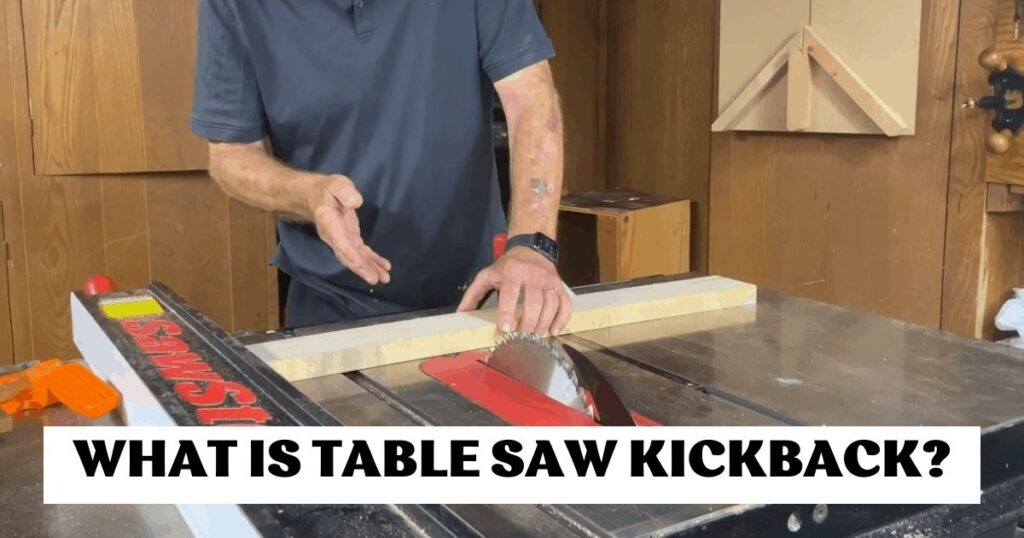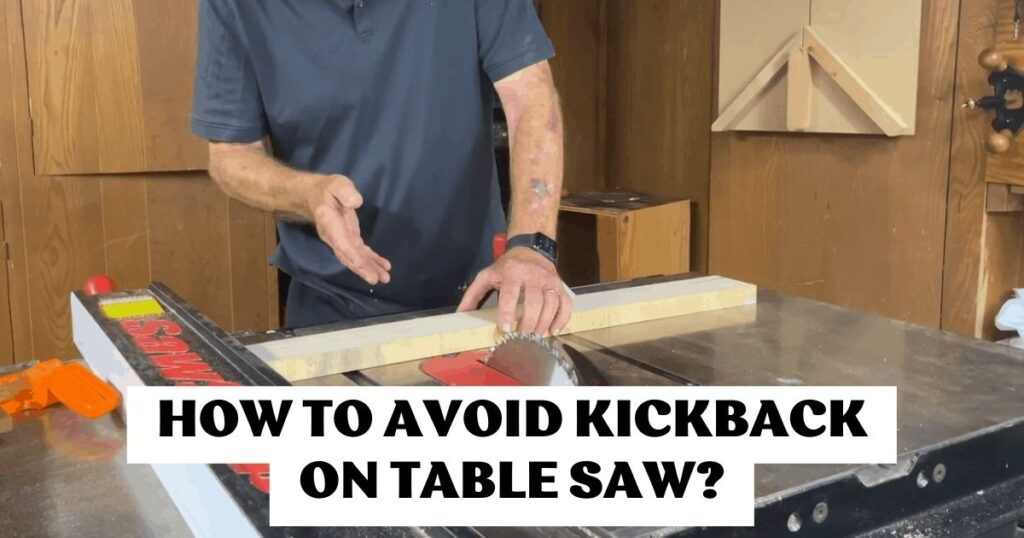People who work with wood often put the table saw in the middle of the shop. In the same way, it’s more dangerous than any other tool. Most of the mistakes that happen at work in a woodshop happen on table saws.
For example, finger and thumb cuts, artery damage, and amputations caused by table saws happen all the time. More than 30,000 people are hurt every year with table saws in the United States, and table saw blades are one of the main reasons for these injuries.
When you use a table saw, table saw kickback can happen, which is very dangerous and could even kill you. In order to keep themselves and others safe, woodworkers need to know what kickback is and how to stop it.
In this article, We go into greater detail about what causes kickback on a table saw, the implications, and how to prevent kickback on a table saw.
What is Table Saw Kickback?

Table saw kickback is when the wood is cut on a table saw and quickly moves back toward the person using it. This could be caused by a dull blade, bad blade orientation, or the wrong feed rate, among other things.
Kickbacks can cause cuts, scrapes, and even amputations. They can also damage the saw and the cutout.
How Does Kickback On a Table Saw Occur?
To stop kickbacks in the workshop, you need to know how they happen. When you’re using a table saw, pieces of work can fly back to you for a number of reasons.
These could be anything from a blade that isn’t lined up right to an offcut that accidentally touches the moving blade. These are the main reasons why table saws kick back.
1)When a Workpiece Rotates Toward the Blade During a Cut:
When cutting, a piece of work can sometimes turn in toward the blade. You could also hurt your hands badly by pulling your hands on top of the blade. On a table saw, this is how most finger accidents happen.
2)When the Kerf on the Back of the Blade Narrows:
When you make a rip cut, the job piece’s kerf may start to close in on the back of the blade. If you are cutting reactive wood or your table saw doesn’t have a splitter, this is likely to happen. Your part could shoot back at you or turn around if you don’t fix this problem. A lot of the time, the kerf closes up when cutting oak.
3)The Piece of Work Gets Stuck Between the Saw Blade and the Rip Fence:
Something that gets caught between the fence and the blade can happen when you make cross-cuts. This could cause a strong kickback, especially if you are standing where the object is going. Sometimes this happens because the fence or blade is not lined up right.
4)Pushing a Workpiece Past the Blade is Not Permitted:
To cut through the cutting resistance, you can push the workpiece through the blade. The piece will be pushed in the opposite direction if you don’t push it all the way through the cut. It could get stuck in your way. To lower the chance of kickback, you need to make sure that your stock goes all the way through the blade.
5)Applying Pressure to the Edge of the Blade:
You have to push the piece of wood through the blade of a table saw in order for it to cut. This is called feeding the table saw. But it’s just as important which way you push the piece as how hard you push it.
When cutting something with a table saw, the force you use must be going in the same way as the saw blade. Unless you do that, the blade may complain by pushing the piece of work away and pulling your hand toward it. People who do this can lose their hands or get other major injuries.
How to Avoid Kickback on Table Saw:

It’s not possible to fully avoid table saw kickbacks, but there are things you can do to make them less likely to happen. You can avoid some of the most common table saw kickbacks by taking the steps below.
1)Stay Away from the Kickback Road:
To stay safe around kickbacks, the most important thing is to stay out of their way. Most of the time, things that come off of a spinning saw blade fly in the direction that the blade is turning.
So, always stand on the side when using the table saw so that the flying bits don’t hit you. Also, make sure you wear the right safety gear, like gloves and a face shield.
2)Equip Your Blade with a Timber Splitter or Riving Knife:
It is important for safety that the table saw has a blade. It keeps the back of the blade’s kerf from getting smaller. A splitter for a table saw is just a small blade that stays in place and is the same width as the saw blade. It is attached to the back of the blade.
The stock can slide through smoothly after coming out at the back of the blade because it is directly aligned with it. This keeps the kerf open to avoid pinching back. A metal splitter also keeps the stock tight against the fence to keep it from getting out of line, which could lead to kickback.
There are two main problems with a table saw wood chipper. For starters, it doesn’t move up or down or tilt with the blade. This means you have to take it off when you cut at an angle. Also, unless you change the short splitter with a taller one, it doesn’t work as well on thick stock.
The second thing is that there is a pretty big space between the saw blade and the bit. This space could make the kerf of some types of wood start to close in before it gets to the splitter, which could lead to kickback. A splitter is still better than nothing.
You can also make your own zero-clearance throat plates and add one. The main anti-kickback tool on newer table saws is the riving knife, while most older ones come with a splitter.
The trunnion holds a riving knife. In other words, it fits on the same part of the saw as the blade. So, the riving knife can move up and down with the blade and tilt with it, but the gap between them stays the same.
Because of this set gap, the riving knife can go into the kerf as soon as the workpiece moves off the back of the blade. This keeps the stock from pinching back, which could lead to dangerous kickbacks. Since this is the case, a riving knife stops kickback better than a splitter. It is safe to have one of them on your table saw, though.
Once you’re ready to cut, always check that the splitter or riving knife is in the right place and lined up with the saw blade. They make using a table saw a lot safer, especially when cutting long pieces in rip cuts.
3)For Rip Cuts, use Dry Wood:
If the wood isn’t dried well, the kerf may close up. When wood is wet, it has a lot of water in it, which makes the grains pull back together after being cut.
When this kind of wood gets close to the splitter, it can cause a lot of friction, which can lead to dangerous kickbacks. So, you should never rip wood that is wet. If you have to do it, though, make sure they are short enough by cutting them to the lengths you need for the job ahead of time.
4)Align Saw Table Fences Precisely:
Make sure the table saw fences are perfectly lined up so that workpieces don’t get stuck and cause violent returns. To make the rip fence line up straight with the saw blade, use the miter slots.
It’s also easy to move the fence a few thousandths of an inch farther away from the blade’s trailing edge. This is also called “fence toe-out.” If you toe out the fence, the offcut won’t get stuck and the kerf will stay open.
When you toe in, you close the space between the fence and the back of the blade. This is something you should never do. A small amount of toe-in on the fence can leave burn lines on cuts. When the fence is toed in too far, the workpiece can kick back and hurt someone.
To line up the miter gauge fence, use the same miter holes and a square. Set up two angles for the fence. Start by using the square tool’s right angle to line it up straight with the saw blade.
Second, set the miter gauge to 45 degrees and use the square’s 45 degrees to measure the angle against the blade to make sure it’s exactly right. On a table saw, these are the most usual times to crosscut.
5)Line Up the Saw Blade:
If the blade isn’t lined up right, a piece of work could get stuck between it and the fence, which could cause a dangerous kickback. So, while you’re adjusting the fence, make sure the blade is also straight. Also, a blade that isn’t lined up right can make cuts that aren’t straight or are burned.
6)Clean the Table and Keep the Saw Blade Sharp:
Kickbacks are easy to happen when the saw blade is dull and the tabletop is rough. This makes it hard to control the project. Make sure your cutting blade is always sharp and the top of your table saw is always as smooth as a mirror to avoid this. To make the surface less rough, you can put wax on it. This will help you get a better handle on the workpieces.
Bottom Line: What Causes Kickback On a Table Saw?
Kickback from a table saw is dangerous and can hurt people badly as well as damage the saw and the workpiece. The people who work with wood need to know how kickback happens and take the right steps to avoid it. Woodworkers can keep themselves safe and lower the chance of the table saw kicking back by using a table saw kickback guard, keeping the blade sharp, and following the right safety steps.
FAQs about What Causes Kickback On a Table Saw?
Why Does Return Happen Most of the Time?
The stock is kicked back at the user when the saw grabs it and throws it back at them. This can happen if the stock bends and gets stuck in the teeth or against the side of the blades. This can happen if the blade isn’t sharpened or is set at the wrong height.
How Dangerous are Kickbacks?
There is a high likelihood that the offered products and services will be of inferior quality. There is a very low likelihood that the vendors or contractors who received kickbacks would perform the work honestly.
Related Posts:
- Can a Track Saw Replace a Table Saw?
- Delta vs Dewalt Table Saw: (Which One is Better)
- Table Saw vs Track Saw: (4 Main Keys Difference)
- Bosch vs Dewalt Table Saw: Which One is Better?
- How To Clean Table Saw Blade?
- How to Change a Table Saw Blade?: (All Methods and Models)
- Why Does My Table Saw Blade Wobble? And (How To Fix)
- How Many Teeth For Table Saw Blade
